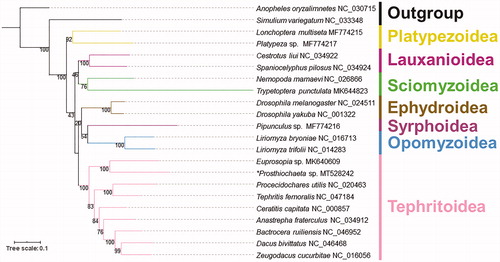Abstract
The mitochondrial genome of Prosthiochaeta sp. was sequenced and annotated as a new representative of family Platystomatidae. The nearly complete mitochondrial genome of Prosthiochaeta sp. is 16,169 bp totally, consisting of 13 protein-coding genes, 2 rRNAs, and 22 transfer RNAs, which gene frame is similar with other dipteran mitogenomes. The nucleotide composition biases toward A and T is 70.8% of the entirety. IQ-tree analysis revealed that Tephritoidea including Prosthiochaeta sp. was monophyletic as a sister group to Opomyzoidea and Syrphoidea. Tephritoidea as well as Syrphoidea and Opomyzoidea were nested in Ephydroidea, while Lauxanioidea and Sciomyzoidea were assigned to be sister groups. Platypezoidea was monophyletic as a basal clade of phylogenetic tree.
Species of Platystomatidae are small to medium-sized (body length 2.5–20.0 mm) and generally have the metallic color (Wendt Citation2016). They are charaterized by the transverse section of CuA2 not indented, cell cup not produced into an acute posterodistal lobe, costal break at subcostal position absent, and incurved lower orbital bristles also absent (McAlpine Citation1998). They are almost distributed worldwide with over 1200 known species (McAlpine Citation1998, Citation2001).
Specimens of Prosthiochaeta sp. (CAU-WL-2019511) were collected in Shengshuige, Emei Mountain, Sichuan province, China (E103.416784, N29.570113) and identified by Liang Wang. The specimens were deposited in the Entomological Museum of China Agricultural University (CAU), Beijing.
The genomic DNA was extracted from an adult’s whole body except head and wings using the DNeasy DNA Extraction kit (TIANGEN) and stored at −20 °C refrigerator. After NGS sequencing, the sequenced reads were assembled by NOVOPlasty 3.7.2. The mitochondrial genome of Prosthiochaeta sp. contains 22 transfer RNA genes, 13 protein-coding genes, and 2 ribosomal RNA genes, which are close to other flies reported before (Kang et al. Citation2016; Li et al. Citation2017; Zhou et al. Citation2017; Yang et al. Citation2019; Hou et al. Citation2020). The mitochondrial genome nucleotide composition of Prosthiochaeta sp. is 39.8% of A, 31.0% of T, 11.1% of G, 18.0% of C, and A + T content is 70.8%. The genes ATP6, COX2, COX3, CYTB, NAD3, NAD4 and NAD4L started with codon ATG; the start codon ATT was shared with genes NAD1, NAD2, NAD5 and NAD6; only ATP8 was started with ATC codon. There were 9 genes (ATP6, ATP8, COX1, COX3, NAD2, NAD3, NAD4, NAD4L and NAD6) terminated with TAA stop codon; CYTB ended with TAG codon; COX2 and NAD5 stopped with single T; and NAD1 terminated with TA.
There is datum of 20 species retrieved from NCBI and 1 new sequenced data used in phylogenetic analysis. Genbank accession numbers are listed as follows: Ceratitis capitata NC_000857, Zeugodacus cucurbitae NC_016056, Procecidochares utilis NC_020463, Anastrepha fraterculus NC_034912, Dacus bivittatus NC_046468, Bactrocera ruiliensis NC_046952, Tephritis femoralis NC_047184, Pipunculus sp. MF774216, Trypetoptera punctulata MK644823, Nemopoda mamaevi NC_026866, Lonchoptera multiseta MF774215, Platypeza sp. MF774217, Liriomyza trifolii NC_014283, Liriomyza bryoniae NC_016713, Cestrotus liui NC_034922, Spaniocelyphus pilosus NC_034924, Drosophila yakuba NC_001322, Drosophila melanogaster NC_024511, Anopheles oryzalimnetes NC_030715, Simulium variegatum NC_033348, Euprosopia sp. MK640609 and Prosthiochaeta sp. MT528242. Thirteen protein-coding genes (PCGs) were used to reconstruct the phylogenetic relationship with IQ-tree (Nguyen et al. Citation2015; Hoang et al. Citation2018) in Phylosuite software (Zhang et al. Citation2020). The topology was given and bootstrap support numbers are shown in . IQ-tree analysis revealed that the outgroups Anopheles oryzalimnetes and Simulium variegatum diverged from the rest. The Tephritoidea including Prosthiochaeta sp. was monophyletic as a sister group to Ephydroidea + (Opomyzoidea + Syrphoidea). All the four superfamilies are paraphyletic with Lauxanioidea and Schiomyzoidea, which were assigned to be sister groups. Platypezoidea was monophyletic as a basal clade of phylogenitic tree.
Disclosure statement
No potential conflict of interest was reported by the author(s).
Data availability statement
The data that support the findings of this study are openly available in GenBank of NCBI (https://www.ncbi.nlm.nih.gov), accession number is MT528242.
Additional information
Funding
References
- Hoang DT, Chernomor O, von Haeseler A, Minh BQ, Vinh LS. 2018. UFBoot2: improving the ultrafast bootstrap approximation. Mol Biol Evol. 35(2):518–522.
- Hou P, Wang L, Li X, Yang D. 2020. First mitochondrial genome of Euprosopia sp. (Diptera: Platystomatidae). Mitochondrial DNA Part B. 5(1):723–724.
- Kang ZH, Li XK, Yang D. 2016. The complete mitochondrial genome of Dixella sp. (Diptera: Nematocera, Dixidae). Mitochondrial DNA A. 27(2):1528–1529.
- Li X, Ding SM, Hou P, Liu XY, Zhang CT, Yang D. 2017. Mitochondrial genome analysis of Ectophasia rotundiventris (Diptera, Tachinidae). Mitochondrial DNA Part B. 2(2):457–458.
- McAlpine DK. 1998. Family Platystomatidae. In: Papp L, Darvas B, editors. Contributions to a manual of Palaearctic Diptera (with special reference to flies of economic importance). Budapest: Science Herald; Vol 3, p. 193–199.
- McAlpine DK. 2001. Review of the Australasian genera of signal flies (Diptera: Platystomatidae). Rec Aust Mus. 53(2):113–199.
- Nguyen LT, Heiko AS, Arndt VH, Bui QM. 2015. IQ-TREE: a fast and effective stochastic algorithm for estimating maximum-likelihood phylogenies. Mol Biol Evol. 32(1):268–274.
- Wendt LD. 2016. Family Platystomatidae. Zootaxa. 4122(1):579–581.
- Yang QC, Li X, Li Z, Pan ZH, Yang D. 2019. The mitochondrial genome analysis of Trypetoptera punctulata (Diptera: Sciomyzidae). Mitochondrial DNA Part B. 4(1):97–98.
- Zhang D, Gao F, Jakovlić I, Zou H, Zhang J, Li WX, Wang GT. 2020. PhyloSuite: An integrated and scalable desktop platform for streamlined molecular sequence data management and evolutionary phylogenetics studies. Mol Ecol Resour. 20(1):348–355.
- Zhou QX, Ding S, Li X, Zhang T, Yang D. 2017. Complete mitochondrial genome of Allognosta vagans (Diptera, Stratiomyidae). Mitochondrial DNA Part B. 2(2):461–462.

